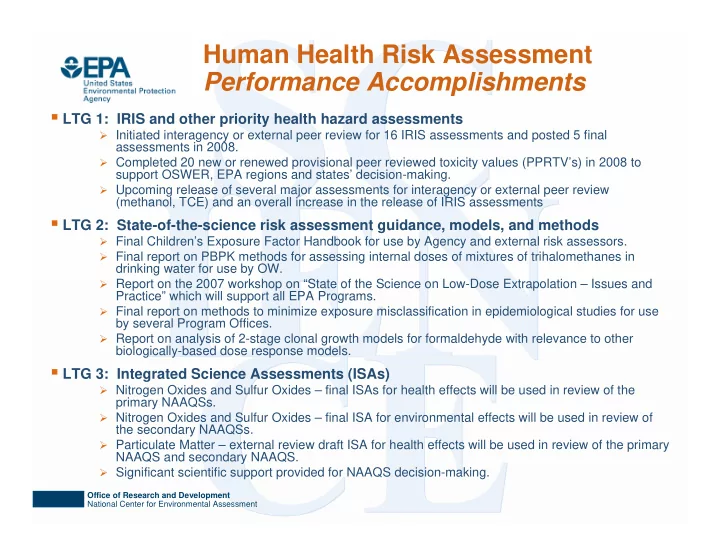

Human Health Risk Assessment Performance Accomplishments LTG 1: IRIS and other priority health hazard assessments ¾ Initiated interagency or external peer review for 16 IRIS assessments and posted 5 final assessments in 2008. ¾ Completed 20 new or renewed provisional peer reviewed toxicity values (PPRTV’s) in 2008 to support OSWER, EPA regions and states’ decision-making. ¾ Upcoming release of several major assessments for interagency or external peer review (methanol, TCE) and an overall increase in the release of IRIS assessments LTG 2: State-of-the-science risk assessment guidance, models, and methods ¾ Final Children’s Exposure Factor Handbook for use by Agency and external risk assessors. ¾ Final report on PBPK methods for assessing internal doses of mixtures of trihalomethanes in drinking water for use by OW. ¾ Report on the 2007 workshop on “State of the Science on Low-Dose Extrapolation – Issues and Practice” which will support all EPA Programs. ¾ Final report on methods to minimize exposure misclassification in epidemiological studies for use by several Program Offices. ¾ Report on analysis of 2-stage clonal growth models for formaldehyde with relevance to other biologically-based dose response models. LTG 3: Integrated Science Assessments (ISAs) ¾ Nitrogen Oxides and Sulfur Oxides – final ISAs for health effects will be used in review of the primary NAAQSs. ¾ Nitrogen Oxides and Sulfur Oxides – final ISA for environmental effects will be used in review of the secondary NAAQSs. ¾ Particulate Matter – external review draft ISA for health effects will be used in review of the primary NAAQS and secondary NAAQS. ¾ Significant scientific support provided for NAAQS decision-making. Office of Research and Development National Center for Environmental Assessment
Human Health Risk Assessment 2010 – 2014 Strategic Directions IRIS and risk assessment methodology ¾ Accelerate IRIS and incorporate new data and methods for improved assessments. ¾ Move towards Next Generation Risk Assessment. Develop methods for the use of new data (e.g., comp tox) in risk assessment. Integrate methods into chemical assessment development to increase quantity of toxicity values available for decision-making. Collaborate across EPA (e.g., NHEERL, NCCT, OPPT). Implement NAS Report “Toxicity Testing in the 21 st Century: A Vision and a Strategy” (2007) and EPA’s “Strategic Plan for Evaluating the Toxicity of Chemicals” (2009). ¾ Increase collaboration with CalEPA and ATSDR to develop health assessments. ¾ Advance cumulative risk assessment (phthalates, PAH mixtures) – to implement NAS report “Phthalates and Cumulative Risk Assessment” (2008) – collaborate with OPPTS and OW. ¾ Evaluate and implement recommendations of NAS Report “Science and Decisions: Advancing Risk Assessment” (2008) – cross-Agency effort. Integrated Science Assessments ¾ ISA process underway simultaneously for all NAAQS pollutants; close coordination with OAR and acceleration possible pending L. Jackson decisions. ¾ Implement Health and Environmental Research Online (HERO) database. Office of Research and Development National Center for Environmental Assessment
Human Health Risk Assessment Significant Anticipated Products (2010-2014) LTG1: IRIS and other priority health hazard assessments Deliver a substantially increased number of IRIS assessments for interagency or external peer review and final posting to support decision-making. Increase Program and Regional collaboration in nomination and prioritization processes. Complete 50 new or renewed PPRTV’s to support OSWER, EPA regions and states’ decision-making each year. This will result in about 400 PPRTV’s being completed during FY09-15. LTG2: State-of-the-science risk assessment guidance, models, and methods Develop guidance and methods for the use of new data in risk assessment. Develop approaches for unifying cancer and noncancer dose-response assessment including moving away from the RfD to a probabilistic approach. Develop methods for incorporating population background risk into dose- response assessment. Improve cumulative risk methods by considering vulnerability, nonchemical stressors, and background risk factors. Update Reference Concentration methods and provide Exposure-Response Arrays for evaluation of risks from varying exposure-time scenarios. LTG3: Integrated Science Assessments Fully implement revised NAAQS process and develop new ISAs for the six criteria air pollutants on a 5-year review cycle meeting Clean Air Act mandates. Sustain scientific support to OAR and Administrator for NAAQS decision-making. Office of Research and Development National Center for Environmental Assessment
Recommend
More recommend